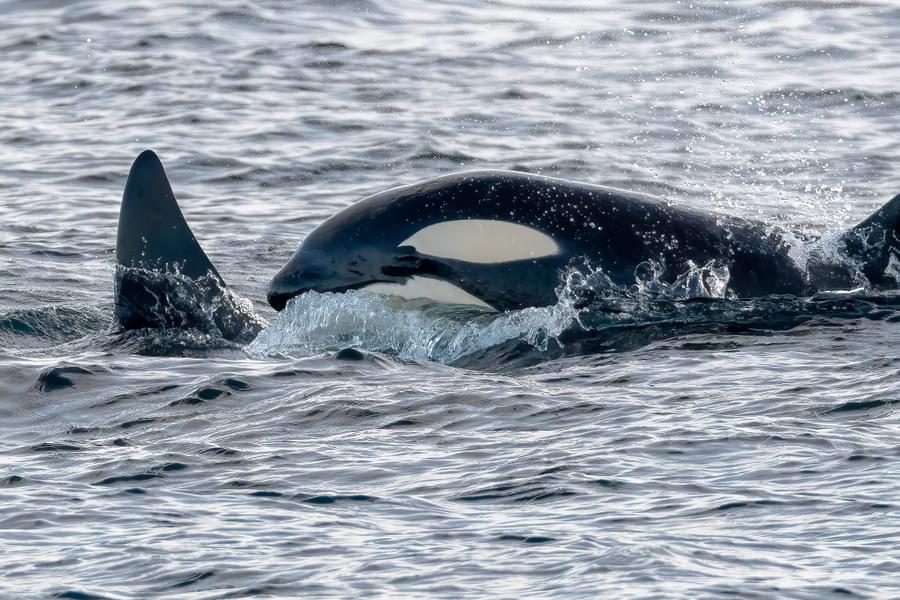Anyone taking an interest in the world of whales, will have read some of the lurid headlines about orcas in the waters off Spain and Gibraltar. “WHALE OF RAGE - Horror moment pack of killer whales attacks tourist boat as they rip off rudder while screaming passengers call for help”, and “Gladis the killer whale and her gang of orcas out for revenge” are two not entirely untypical examples.
Over 80 marine experts and organisations, including ORCA, have put their names to an open letter decrying the demonising of this species, and trying to unpick just what is going on.
There has been intense public interest in the interactions between orcas (referred to hereafter as the Iberian orcas) and marine vessels along the coast of the Iberian Peninsula (Spain and Portugal) and in neighbouring waters. So just what is going on?
The orcas have shown a wide range of behaviours during the interactions, many of them consistent with playful social behaviour. The Iberian orcas are categorised on the International Union for Conservation of Nature’s Red List as Critically Endangered. There may be fewer than 40 individuals in this population. They represent a geographically isolated, genetically distinct subpopulation, which feeds primarily on bluefin tuna.
These disruptive interactions with vessels began in earnest in July 2020. To date, at least 11 juveniles and four adult females have been identified as participating in, or observing, the interactions. There is no evidence of an identifiable ‘leader’ of these interactions. Researchers have given these 15 whales the Latin identifier Gladis and an individual name; for example, Gladis Blanca or Gladis Negra (White Gladis and Black Gladis, respectively, in English). Gladis Negra, a juvenile female - and one of the initially reported interacting animals—was observed with a head laceration in spring 2020 and a wound behind the dorsal fin later in 2021. Both injuries were of unknown origin.
The interactions have ranged from no contact with the vessel, through mild or moderate contact with no or minor damage to the vessel, to significant contact with severe damage (preventing navigation). Starting in spring 2021, at least five damaged vessels have sunk, but even so severe damage has occurred in only 20% of the interactions.
Despite the damage to vessels, characterising the interactions as ‘attacks’ is misleading. It might make for a great clickbait headline but it’s far too simplistic.
The predominant damage to rudders and keels are due to strikes or rams with the head or body. The whales are not ripping the rudders apart, as they might if this were hunting behaviour. While the behaviour may undoubtedly be frightening (and costly) from a human perspective, from the whales’ perspective, it seems to be somehow gratifying.
Anyone on a boat that has been subject to one of these interactions might not unreasonably feel they’ve been subject to an attack. But orcas are the size of a small bus, and so what in their mind is playful behaviour might not feel like it in the reality of the recipient. An over-excited and playful St Bernard puppy can knock an adult off their feet but there’s no malice in their behaviour.
All very well, but this still doesn’t explain the behaviour. And this is where it gets really interesting. Orcas (and other dolphin species) elsewhere have been known to develop cultural ‘fads’ - that is to say, novel behaviour that briefly persists and expands within a population. Back in the 1980s, in the Puget Sound area of the northeast Pacific, one female orca from k-pod began carrying a dead salmon around on her nose. Over the next 5-6 weeks, the behaviour spread, and by the end of it, orcas from her own and two other pods were wearing dead salmon hats. Then all of a sudden, the fad was over. Bar a few times the following summer – latecomers, like humans just now deciding to wear Crocs – the trend has never been seen again.
While these vessel interactions may be a similar phenomenon, they are persisting longer than typical fad behaviour, expanding within the population and even outside it and escalating in impact. Nevertheless, it is possible the behaviour, as previous fads have, will disappear as suddenly as it appeared.
The problem of over-interpreting the behaviour is that narratives which demonise these otherwise gentle giants can start to become accepted truth. In the absence of further evidence, people should not assume they understand or even second-guess the animals’ motivations. The orca is an intelligent, socially complex species, and each population has its own culture - different vocalisations (known as dialects), prey preferences, hunting techniques, even different social structures and migratory behaviours. The idea that they are a renegade lynch-mob out to avenge the ills which humans have inflicted on their species is amusing but far-fetched.
It is absolutely the case that Iberian orcas are exhibiting a behaviour never before seen with this consistency among cetaceans - even in the days of industrial whaling from wooden ships and boats, when as Captain Ahab found to his discomfort that far larger whales were known to smash or otherwise damage vessels, such incidents were relatively uncommon. Science cannot yet explain why the Iberian orcas are doing this, although we repeat that it is more likely related to play/socialising than aggression. However, it is unfounded and potentially harmful to the animals to claim it is for revenge for past wrongs or to promote some other melodramatic clickbait headline.
Lucy Babey, Director of Programmes at ORCA said; “When we are at sea, we are in a world that is different to the one we are familiar with and it will continue to surprise us. We should not seek retribution when wildlife behaves wildly or for behaviour change that we cannot immediately understand. As humans, we need to put greater effort into adapting our own actions and behaviour in the presence of wildlife. The survival of the species with which we share this planet depends on it.”
Main image credit: Kev Barwell

